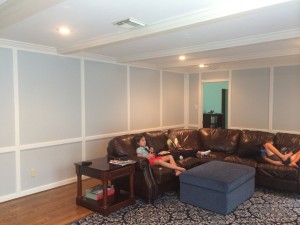Homeschooling moms are routinely overwhelmed with how to occupy the little ones while the big kids are doing their schoolwork. (And since many families opt to keep their toddler and pre-school aged kids at home, this post isn’t just for homeschooling mothers.) Like many of you, I was overwhelmed as well, until I started a daily toddler circuit, and now our mornings are flowing much more smoothly. I have only one child of actual school age (Gianna–1st grade), and while Charlie is now ready for a small amount of seatwork and writing, he is still pre-school age, so I like to include him in our daily circuit prior to his workbooks. I have spent the better part of this year working on a circuit system for my two boys (Gus, age 3 and Charlie, age 5). The goal of the circuit is twofold, (1) it should provide fun and educational activities for kids ages 2-5 and (2), it should keep order and structure in the school room. All this leads to a sane mom, happy kids, and productive older children.
The concept is pretty basic. I gather various age appropriate and stimulating activities for kids ages 2-5. I want these activities to represent various skill sets, for example, counting, patterns, fine motor skills, colors, alphabet, etc.. All pre-schoolers do the same activity for 20 minutes, then I swap in a new activity. We do 3-4 activities each morning. At the end of the circuit we do a read aloud, which also lasts for 20 minutes. Overall, the pre-schoolers in my house are occupied for around two hours each morning. They have fun, I have fun, we have structure, and everyone is learning.
Just recently I began caring for my 4 year old nephew several days a week. After a few rough days of chaos, occasional fighting, and very little schoolwork, I decided to be much stricter about our circuit. All three boys would be required to participate for at least 3-4 rounds, plus read aloud time. The first two days were a bit of a disaster. My nephew and both of my sons regularly asked to do other activities. If I said yes, all boys wound up in the playroom. Fighting would quickly ensue, and soon toys were coming into the schoolroom and Gianna was participating in their play and completely neglecting her work. I soon insisted that all three boys sit for each round of the circuit. Each activity would last only 20 minutes. I explained this and set the timer in clear view of the boys. They had two choices, either they could do the activity, or they could sit in their seat and rest until the timer went off. It took a day or two to let them know I was really serious, there was some complaining, but now, only one week later, I have all three boys asking to do school immediately after breakfast!
The system is working so well that I wanted to share it with all of you.
I included some pictures of our activities, and here they are in list form–
1) Playdough
2) Pattern Blocks
3) Linking Cubes
4) Lace-up Cards
5) Flash cards and number counting
6) Beading (you can use penne and even paint it before you make necklaces)
7) Coloring
8) Magnet/Puzzle letter play
9) Sorting with vehicle counters
Here are some tips/pointers–
1) Start with playdough or another really hands on activity. We begin each day with 20 minutes of playdough. We make our own, and each child has their own color, making it more personal and inviting.
2) Introduce only one new activity each day. This allows mastery of certain skills and also allows children to concentrate with familiar things like play dough.
3) Save circuit or school toys for school so that the supplies are new and exciting.
4) Have at least 8-10 activities so everything remains new and exciting
5) If you are really organized, make a schedule so that all activities find their way into the circuit, also consider allowing the children to choose between two things for the next activity.
6) Be strict about your 15-20 minute time requirements. If the kids get bored, tell them they have two choices, they can either sit and rest until the timer goes off, OR they can participate. If the kids want to continue playing with the activity after the timer ends (this happens with the playdough in our house!), insist that they clean up, otherwise the activity loses it’s luster and isn’t nearly as exciting the next day.
7) Incorporate seasonally appropriate crafts and activities into the circuit.
Please comment with any ideas and tips you have for circuit activities or variations of the circuit that work in your home. In addition, here are some helpful links with more ideas (h/t MaryAlice)– :clown:
The Alphabet Box, with laminated pictures or objects
And I will post my playdough recipe later this week!











